Reduce tissuemaking costs and improve profiles with AirCap Heli
Valmet uses customer feedback to improve the tissuemaking process. This was critical in the development of the patented Valmet Advantage AirCap Heli which improves profiling and drying uniformity while reducing costs in the tissuemaking process.
Background
Valmet has a long history in developing, constructing and supplying aircaps and hoods, and the standard Advantage AirCap is a well established and proven technology with a robust design. The standard AirCap can maintain the distance between the hood and the sheet on the yankee at all operating temperatures to within 3/4", therefore giving tissuemakers good energy consumption in the drying process.
Customer feedback: uneven moisture profile
One of the common problems about which we have received customer feedback is the uneven moisture profile at the reel. This can have a multitude of contributing factors. Typically, on the hood there are two ways to overcome an uneven profile: utilize profiling dampers, which then impacts your energy consumption; or overdry the sheet. Both of these methods have a negative impact on your bottom line.
In the standard cross nozzle box hood design there's a fairly even cross machine temperature and impingement velocity distribution. But one of the inherent issues with cross nozzle boxes is that in certain areas you get a slightly lower drying contribution due to internal turbulences. There are also areas where you are coming into contact - heat exchange between the hot supply air and the cooler exhaust plenum air. This converts to slight differences in cross machine direction with regard to impingement temperature and impingement velocity, therefore impacting the cross machine moisture profile.
Valmet R&D development
We challenged Valmet's research and development to overcome the customer reported issue of areas with slightly lower impingement temperature and impingement velocity.
First, we considered putting static mixers at the inlet to the crescent headers. This would be great for mixing air and improving the temperature distribution. But it would increase the pressure drop, resulting in an increase in energy consumption electrical. So that idea wouldn't work.
Next, we looked at how to improve the issue regarding heat exchange from the crescent headers coming into contact with the cooler exhaust plenum air. We thought about insulating the crescent headers with ceramic insulation. Another great idea, but very expensive, and it would considerably increase the weight of the hood.
Advantage AirCap Heli is created
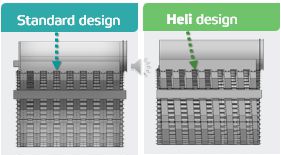
The Advantage AirCap Heli is shown on the right side of this graphic. The novel difference is that the crescent headers themselves are slanted. We will see how this helps to improve the cross machine moisture profile.
Cost savings of reducing drying
First, let's look at what the cost impact is of using a profiling damper to correct an uneven profile, or overdrying of the sheet. As an example, we will consider a typical 200 inch wide machine with an 18 foot yankee, running 6500 feet per minute, with fiber costs of around 550 USD/ton. Reducing the final sheet dryness from 96% to 94% would give an gas energy consumption reduction of around 225,000 USD/year. We could also reduce fiber use by just over 2% at the same final weight. This gives an annual savings of about 437,000 USD. These are big numbers!
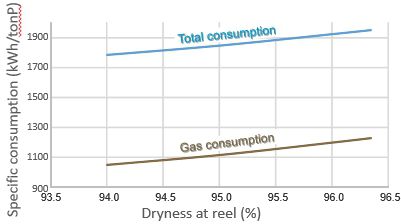
Specific energy consumption vs dryness at the reel - the energy savings when reducing 96% dryness to 94%
How does the Advantage AirCap Heli improve profiles?
Standard hood profiling creates a profile step change
The graphic below shows four of the profiling zones on the wet end of a standard hood, with the typical 14" (360 mm) profiling zone width. As all tissuemakers know, moisture profiling issues are rarely entirely under one of those profiling zones. They are usually between or across multiple profiling zones.
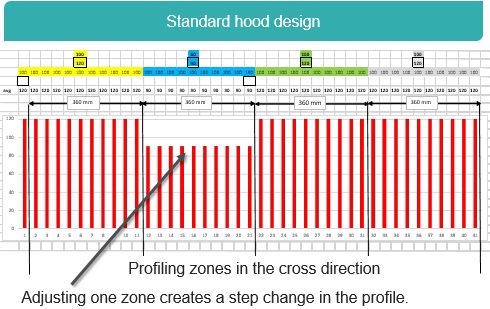
Adjusting one zone on a standard hood creates a step change.
When trying to use a use a standard hood to modify a moisture profile, we are limited. As shown in the second profiling zone in the graphic, when you start to close a profiling zone, you get a very big step change in the final moisture profile.
Advantage AirCap Heli produces a gentle profile
In this next graphic, we are using the Advantage AirCap Heli with slanted crescent headers. The vertical axis is the machine direction and the horizontal axis is the cross direction. Each of the vertical lines represents a profiling zone.
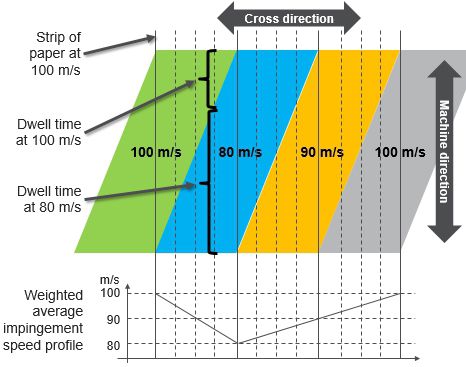
Gradual impingement speed change with slanted headers of Advantage AirCap Heli
The sheet that is going under the profiling zone is impacted by different impingement velocities as you open or close some of the dampers across the machine. Thus, the Advantage AirCap Heli provides a gradual impingement speed change across the sheet.
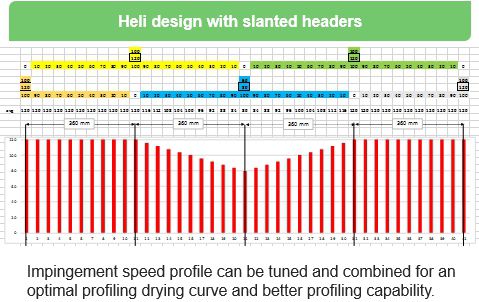
With AirCap Heli's slanted headers, the impingement speed profile can be tuned gently for an optimized drying profile.
The Advantage AirCap Heli allows you to produce a much gentler profile on the sheet, covering more than just one profiling zone. It is a great tool for improving your cross machine moisture profile when you have an issue upstream of the drying section.
Of course, most of the impact on the drying is going to happen on the wet end, so that's where all the profiling dampers are. The dry end only has the edge profiling dampers to prevent edge overdrying.
The system is flexible and easy to control. Advantage AirCap Heli is a great tool for the tissuemaker to improve the final cross machine moisture profile.
Proven results with Advantage AirCap Heli
In a late 2017 rebuild for a confidential customer, the moisture 2-sigma before the rebuild was 1.39. In this rebuild Valmet only changed the wet end hood - we kept the dry end hood in place. Valmet guaranteed a 2-sigma of under 1.0. The actual results were far better than the guaranteed value. The mill was able to get the 2-sigma down below 0.79. We are currently working with mill personnel to try and improve on this 2-sigma and further reduce it to 0.4.
To summarize, here are the benefits that the Advantage AirCap Heli gives the tissuemaker.
- First, there is energy consumption reduction, because you do not need to overdry the sheet. Plus, you are selling less fiber in your final product.
- The tissuemaker is given improved profile capability.
- There is uniformity in cross machine drying, which then impacts even consumption of the coating, even creping, and better product coming off the creping blade onto the jumbo roll. And then consequently, when you take it into converting, there is improved runnability.
For more information about reducing your costs while improving product quality in your tissuemaking process with Valmet Advantage AirCap Heli, contact your Valmet representative.